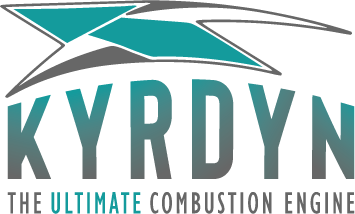
Vous parlez français, cliquez ici
KYRDYN ! RETENONS BIEN CE NOM
Il sera bientôt synonyme de rendements jamais vus dans le domaine des moteurs à combustion interne !
Ce nouveau moteur principalement destiné aux véhicules utilitaires et autres applications industrielles, utilise un échangeur de chaleur pour propulser son rendement effectif à des hauteurs inédites en fonctionnement sous charge faible à intermédiaire.
You speak English, click here
KYRDYN! REMEMBER THIS NAME
It will soon be synonymous of striking efficiencies in the field of Internal Combustion Engines (ICEs)!
This new engine primarily intended for industrial vehicles and other industrial implementations, uses a heat exchanger to dramatically enhance its efficiency under low and moderate loads.
Sie Sprechen Deutsch, hier klicken
KYRDYN! … EIN NAME, DEN MAN SICH MERKEN SOLLTE Sehr bald ein Synonym für eine nie zuvor erreichte Effizienz bei Verbrennungsmotoren !
Diese neue hauptsächlich für Nutzfahrzeuge und andere Industrieanwendungen entwickelte Maschine verwendet einen Wärmetauscher um deren Effizienz bei niedriger bis mittlerer Last drastisch zu erhöhen.
A new Internal Combustion Engine ? Now ?
YES !, Kyrdyn says, more than ever, Our Planet URGENTLY needs it!
Climate, resources, geopolitics,…, the field of energy copes with tremendous challenges more and more insistently calling for solutions which must be not only efficient, but at the same time realistic and readily operable within short.
Immediately reducing the carbon emissions by 10% would be of considerable advantage by slowing down the growth of the CO2 stock in the atmosphere and other telluric receptacles, such as oceans. The more radical technologies, hopefully available, but in a farther future, will then have it much easier in bringing back the stock of CO2 towards acceptable levels. Accordingly, the positive environmental impact of admittedly partial, but immediate solutions will be highly beneficial not only during the delay until operability of the radical solutions, but during tens of years thereafter, or more.
To illustrate it more concretely, the CO2 percentage in the atmosphere more depends on the past emissions than on the current ones. And certain parameters like the amount of melted ice in turn more depends on the CO2 stocks of each past year than on that of the current year. Even if the emissions were brought back to zero, the ice would go on melting as long as the CO2 stock is in excess.
And what about the « all-electric » option? The 100% electric solutions do not fit every situations, especially generators, off-road vehicles, areas or countries lacking charging stations, shipping etc. It should also be mentioned that the environmental balance of a modern Diesel (not to speak of a KYRDYN® engine !) sustains comparison with other energy sources such as energy produced by gas- or coal-fired power plants.
Geopolitically speaking, gas supply is becoming scarce, more than oil, arriving by sea. Therefore, the production of electricity from gas is at issue. Moreover, new opportunities are to emerge in the field of synthetic fuels and bio-fuels, much less critical regarding environment, and overturning most or all geopolitical issues.
From all of this, it is clear that humankind will continue to need combustion engines for a long time to come, not as a second-best solution, but as a truly optimal solution in many contexts. Of course, the most efficient of these future engines is the diesel engine.
… while waiting for the KYRDYN® solution!
The KYRDYN engine, what benefits ?
The KYRDYN® engine suits implementation in trucks, buses ; agricultural, building and mining machinery ; ships, locomotives, generators ; etc.. Automotive use is technically possible and relevant as well, depending on the regulations regarding motor-cars powered by combustion engines, country by country.
Increasing the final efficiency by 5 points, i. e. from currently about 45 % to 50 % at the best point of operation of a truck engine, represents more than 10 % fuel savings. On a 38t long distance truck, currently burning 25-30 liters/100km (or yielding 8-10 mpg), such an increase represents a saving of at least 2.5 to 3 liters/100 km (about 1mpg), thus 12,500 to 15,000 liters after 500,000 km (3-4,000 gallons after 300,000 miles), so about 20-25,000 € savings (according to current fuel prices in western Europe) and…. 30-35 tons CO2 less in the atmosphere, wherever in the World.
Beyond fuel savings, a modern engine must meet or if possible exceed the emission standards in force, and more generally appear as exemplary in this respect. More specifically, it would be desirable to enhance the NOx elimination over currently available Diesels during the warming up phase and low load operation.
For a professional user, two main qualities expected from an industrial engine are, equally, a favourable operational expenditure (OpEx), which is closely connected to engine efficiency, and reliability. Of course, the engine should also exhibit advantages in terms of investment cost (Capital Expenditure, CapEx), space requirement, weight, noise, maintenance, etc..
For the manufacturer, a new engine technology should as far as possible allow the use of proven technologies and prior know-how, require no more than moderate industrial investments/adaptations, keep the manufacturing costs within limits, promise reliability and confidence among the clients, shorten the delay until commercialization. The new technology must allow a selling price which be at the same time competitive and profitable. Improved environmental properties are highly desirable.
Beyond its efficiency performances, the KYRDYN® engine brilliantly meets all the above-presented expectations:
- Conventional engine architecture is wholly kept.
- The additional components are essentially static.
- The additional manufacturing costs of the engine are almost ridiculous in view of the savings rendered possible during exploitation of the engine.
- The additional weight is reasonable and can be compensated by reducing the capacity of the fuel tanks without damaging the range, thanks to the reduced fuel consumption.
- The NOx are inherently better eliminated during operation under low load and during warming up of the engine.
The issue of conventional Diesel Engines efficiency
In a modern Diesel, the working gas (air or air + EGR) delivered by the compressor of the turbocharger is cooled down by a so-called intercooler before being allowed to enter the cylinder of the engine, where said gas is heated by compression, up to a temperature high enough for igniting the fuel injected at the end of the compression. The average combustion temperature, an essential parameter for the efficiency of the engine, lies somewhere between the temperature at the end of the compression and the peak temperature reached at the end of the combustion. The higher the load, the higher the peak temperature and the peak pressure.
The conventional engine is designed thereby to withstand the highest temperature and pressure liable to occur in use, i. e. those at full load, in other words when the engine delivers its maximum torque.
In a great majority of the implementations, however, the full load operation is exceptional. Atruck or bus driver only needs the maximum engine torque during acceleration or along climbing roads, especially when the freight is heavy, which is far from being always the case. Otherwise, that is at least 90% of the time, the engine does not even deliver 50% of its maximum torque. As a result, the conventional engine does not exploit its potential in terms of temperature and pressure, hence of efficiency.
- The Diesel locomotives used in certain countries only need full torque when launching the train and along a sloping railroad.
- Generators are loaded in proportion to the required electrical power which is rarely maximum.
- Farming tractors sometimes work at plowing, but also at other, less energy-consuming tasks like fertilizer application and many others.
- Building machines experience a highly variable load.
- Boat propulsion needs a power depending on cruising speed, freight, currents (especially in the case of river transportation).
And what about KYRDYN ? How does it work ?
A heat exchanger is mounted in parallel with the intercooler.
A controlled valve distributes the intake gas (air + EGR) between the heat exchanger and the interccoler.
The intake gas travelling through the heat exchanger is heated by the exhaust gas without being mixed therewith.
Both paths, through the intercooler and through the heat exchanger respectively, merge together before intake into the engine cylinder.
The engine works as follows:
- Low loadAt low load, all of the intake gas passes through the exchanger and comes out at a temperature close to that of the exhaust gas when it leaves the turbocharger turbine.
- Medium loadAt medium loads, the pilot valve sends an adjusted portion of the inlet gas into the exchanger.
- Maximum loadAt maximum load, all the intake gas can pass through the intercooler and the operation then converges to that of a conventional diesel.
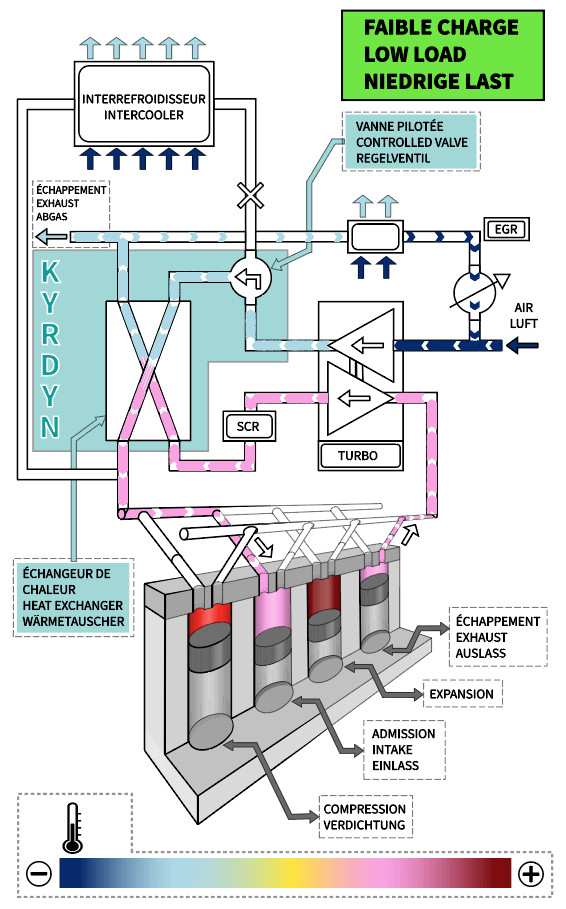
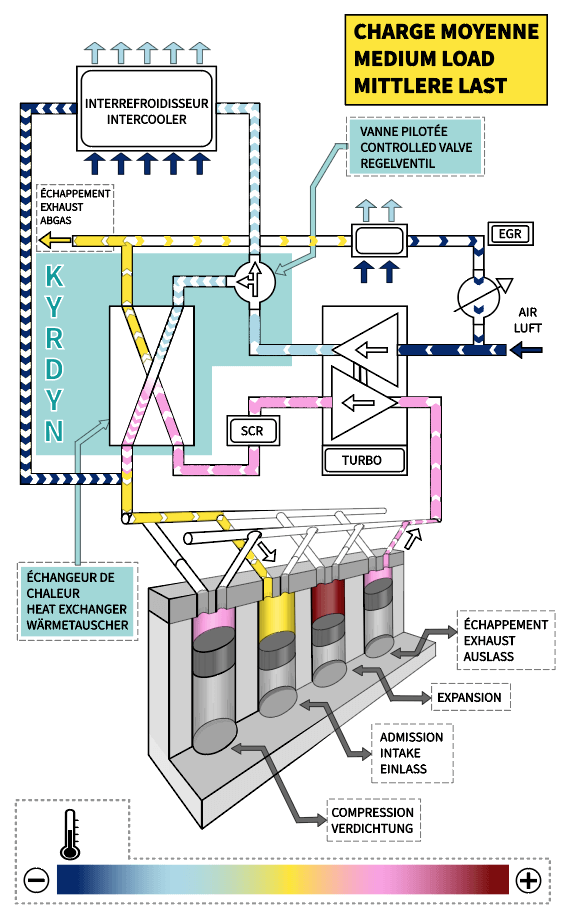
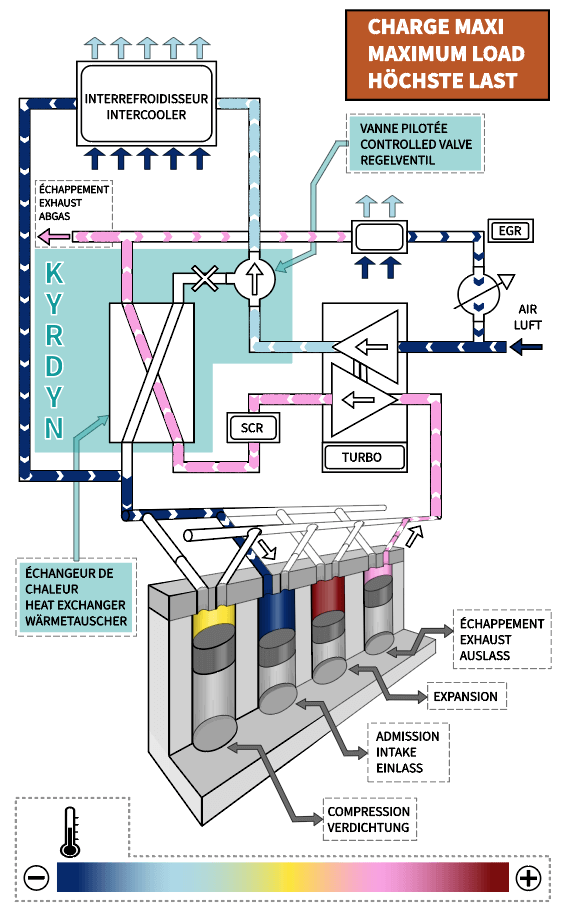
Before reaching the one and/or the other path, the intake gas is precompressed by any means, such as turbocharger, electrically assisted or not, supercharger, or any precompression solution, possibly multi-stage, intercooled or not.
For each operational situation as defined by a number of detected parameters, an engine management software elaborates optimized operational parameters corresponding to an appropriate version of the KYRDYN® cycle. The precompression facilities and the controlled valve are controlled by the engine management software for the couple pressure-temperature to match a desired point of the elaborated version of the KYRDYN® cycle.
Generally, the intake pressure is higher than in a conventional Diesel. So is also the intake gas density, despite the higher temperature. For compensation thereof, i. e. for limiting the mass of gas entering the cylinder despite the higher gas density, the intake valve may close earlier than conventional, resulting in a Miller-type intake. Under part-load, the pressure and temperature at the end of compression are higher in a KYRDYN® engine than would be in a similarly loaded conventional Diesel The heat recovered from the exhaust has the same heating effects for the intake gas as a cost-free precombustion at a selected pressure. Those effects are then multiplied by the subsequent compression in the cylinder. For instance, if the intake gas is heated up by 150°C (270°F) in the heat exchanger, the temperature increase at the end of compression typically amounts to about 300°C (540°F).
Two main results are obtained :
- The efficiency of the engine, which is all the higher as the temperature of the gas rejected into atmosphere is low as compared to the combustion temperature, is definitely improved. As a matter of fact, the thermodynamic efficiency of the cycle reaches values of more than 80 % at part-load. In view of this, an increase of the actual efficiency by 5 points is a perfectly realistic perspective, not to say careful.
- Under low to medium load, the general increase of the temperatures throughout the engine (except downstream of the exhaust path of the heat exchanger, as explained above !) especially raises the temperature of the gas exiting the turbine of the turbocharger. The deNOx catalysor, if arranged between the turbine and the heat exchanger, is accordingly subjected to an increased temperature, promoting its efficient operation. As a result, the NOxs are much better eliminated at part-load. During the warm-up phase, the catalysor reaches its optimum temperature earlier. In other words, as a bonus, the KYRDYN® engine also addresses the frequent objection against modern Diesels regarding emissions during the warming up phases and under low loads.
With a couple of words :
The main additions to a conventional Diesel are limited to a heat exchanger, a controlled valve, and associated piping.
The modifications concern the precompression apparatus (turbocharger or so), the engine management and the intake valve actuation.
- The KYRDYN® engine offers decisive arguments over its Diesel competitors ;
- The KYRDYN® engine increases still further, and very significantly, the advantages of a conventional Diesel over the electrically-ignited engines (« gasoline engines » or so) in terms of efficiency and CO2 emissions ;
- In the fields where the ICEs are currently challenged, the KYRDYN® engine still strengthens the ecological advantages of ICEs over those solutions using certain previously transformed energy, especially electricity produced in gas- or coal-fired power plants.
As a whole, the KYRDYN® engine is a necessary improvement for its users and for Our Planet!
The KYRDYN story
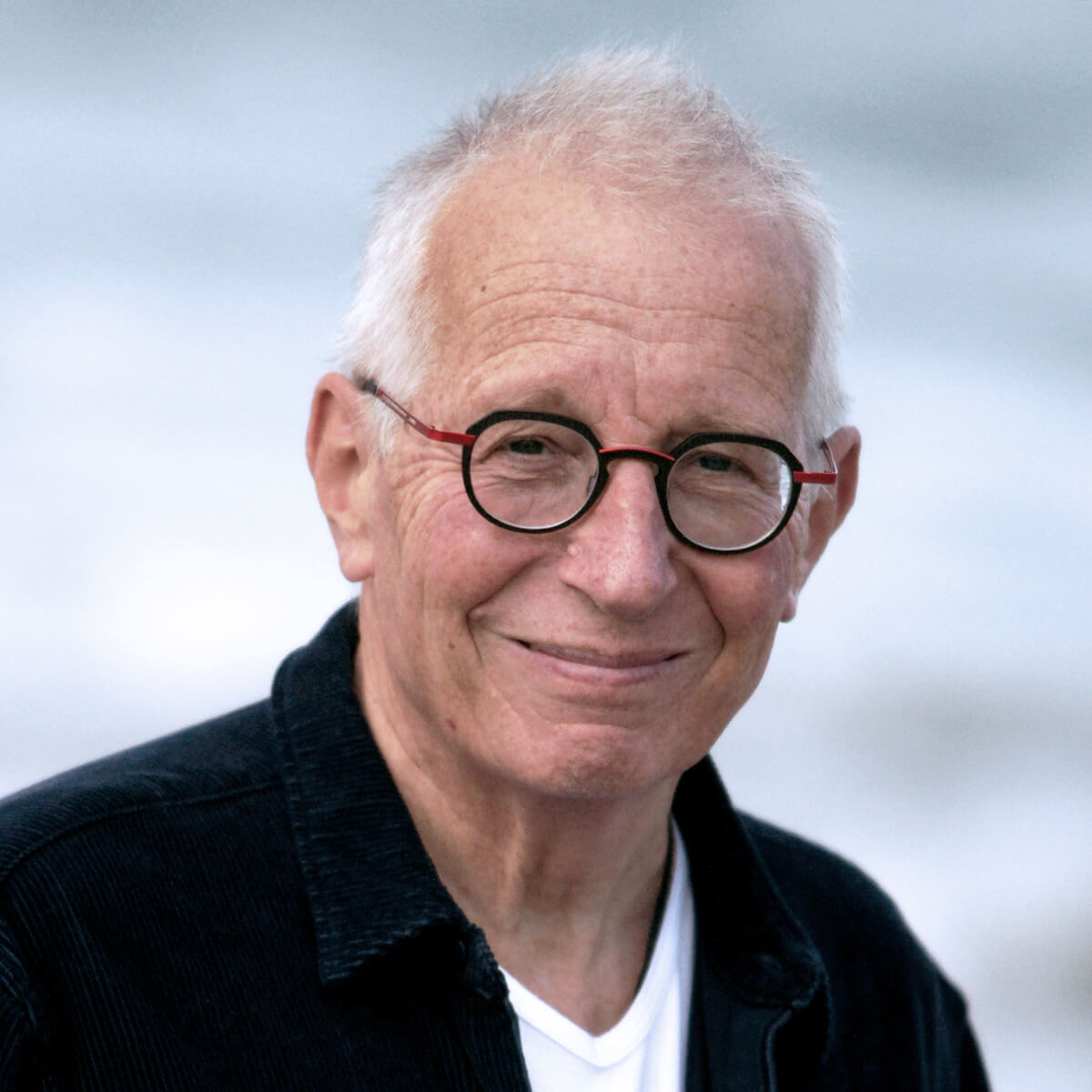
Bernard PONTET
Partner, President
Email : bpontet@kyrdyn.com
The KYRDYN® engine has its origins in thoughts initiated some fifteen years ago by an engineer, Bernard PONTET, specializing in thermodynamics and passionate by the subject. Bernard promised himself to finally eradicate the energy waste through the exhaust of internal combustion engines, even those at the cutting edge of the current technology.
He will have needed almost a decade, and numerous wrong tracks, until his determination leads to the discovery of a solution in which he could believe, in spite of his acute sense of self-criticism.
The idea born in Bernard’s mind consists in using the waste heat, not to feed an ancillary machine again generating its own losses, but as an ancillary heat source for the main machine itself. As a consequence, both sources, combustive and ancillary, use one and the same exhaust, which moreover is cooled down. Hence the spectacular improvement in the efficiency of the machine. And no need of a second machine.
At the present stage, the engine is being developed by a team of engineers gathering high level skills in the fields of thermodynamics, mechanics, mathematics and software.
Contact us for more information
If you have any questions or comments about KYRDYN, here’s how to reach us.
Or contact us at kyrdyn@kyrdyn.com